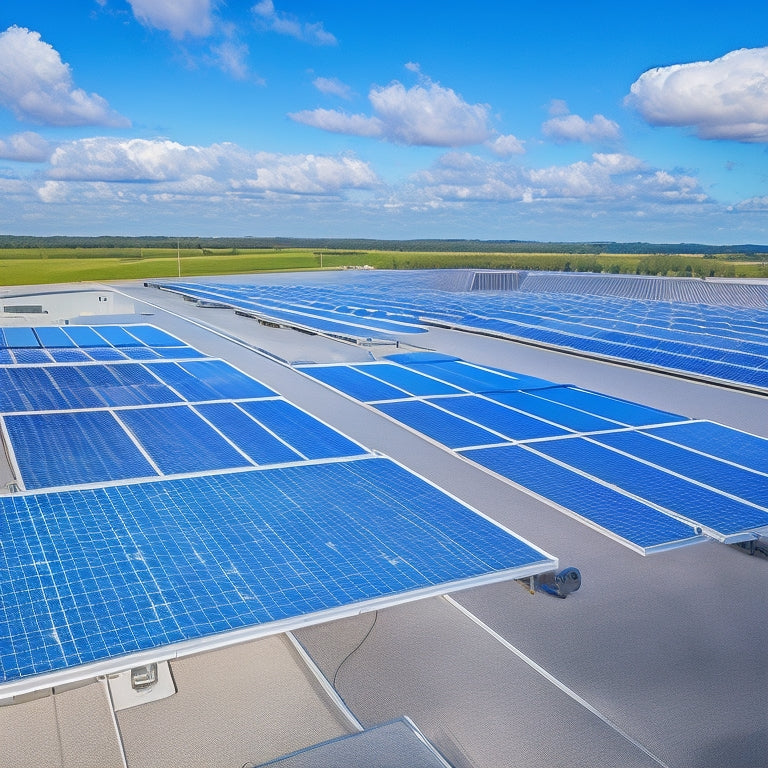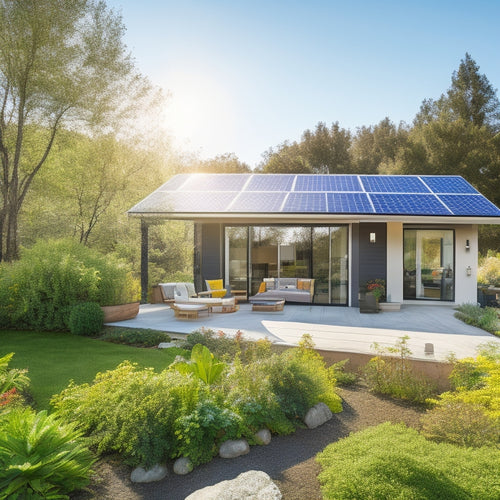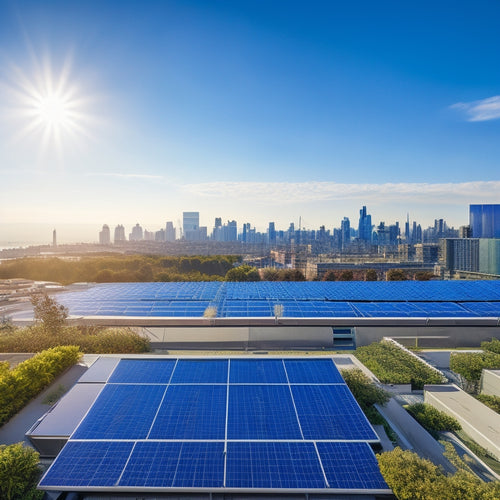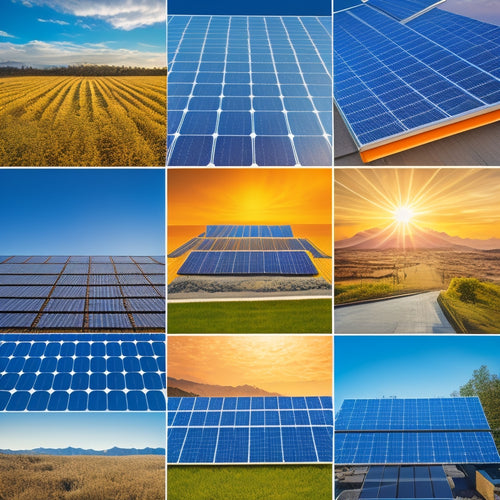
Designing Commercial Solar PV Systems for Maximum Efficiency
Share
When designing a commercial solar PV system for maximum efficiency, you'll need to take into account multiple factors. Start by evaluating the site's solar irradiance, shading, and structural integrity, as well as the facility's energy consumption patterns and peak demand. Then, select the best system components, guaranteeing compatibility and high-efficiency ratings. Configure the system layout, specifying module orientation and tilt to maximize energy production. You'll also need to enhance energy harvesting, conduct shading analysis, and implement maintenance strategies to secure peak efficiency. By following these steps, you'll be well on your way to creating a highly efficient commercial solar PV system, and uncovering the subtleties of each step will be vital to achieving the best performance.
Key Takeaways
- Conduct thorough site assessments to evaluate solar irradiance, shading, and structural integrity for optimal system design.
- Select high-efficiency system components that ensure seamless integration and performance, balancing upfront costs with long-term savings.
- Optimize system architecture by configuring ideal string inverter arrangements, module orientation, and tilt for maximum energy production.
- Implement energy harvesting optimization strategies, including shading analysis, sun path analysis, and temperature effect mitigation.
- Develop proactive maintenance strategies, including regular cleaning, inspection, and monitoring to ensure peak system efficiency and reliability.
Assessing Site and Energy Needs
When evaluating a potential site for a commercial solar PV system, analyzing the site and energy needs is an essential first step. You must assess the site's solar irradiance, shading, and structural integrity to determine its suitability for a solar installation. This involves evaluating the site's energy consumption patterns, including peak demand and overall energy usage.
You'll need to review the facility's energy bills and meter readings to understand its energy consumption profile. Conducting a thorough site evaluation helps you identify potential challenges and opportunities.
You'll need to take into account factors such as roof size and condition, available space for ground-mounted systems, and potential obstructions like trees or buildings. By analyzing energy consumption patterns, you can determine the ideal system size and configuration to meet the facility's energy needs.
An extensive site evaluation and energy needs assessment lay the foundation for a successful commercial solar PV system design, ensuring maximum efficiency and energy savings.
Selecting Optimal System Components
You've assessed the site and energy needs, and now it's time to select the ideal system components for your commercial solar PV system. This vital step guarantees that your system operates at maximum efficiency and meets your energy goals.
When selecting components, consider compatibility to guarantee seamless integration and peak performance. Look for high-efficiency ratings in solar panels, inverters, and other equipment to minimize energy losses.
Conduct a thorough cost analysis to balance upfront costs with long-term savings. Maintenance strategies, such as easy module replacement and cleaning, can also impact system efficiency. Warranty considerations and manufacturer reliability are essential in guaranteeing that your system operates trouble-free for years to come.
Stay up-to-date with technology advancements, such as bifacial panels and advanced inverter designs, to maximize energy production. Finally, consider installation practices, such as optimized panel orientation and row spacing, to further enhance system efficiency.
Configuring System Architecture
When configuring a commercial solar PV system's design, you'll need to determine the ideal string inverter configuration to guarantee efficient energy harvesting.
You'll also need to decide on the series and parallel wiring arrangements to achieve the desired voltage and current outputs.
Additionally, you'll have to specify the module orientation and tilt to maximize energy production based on the site's location and environmental conditions.
String Inverter Configuration
String inverter configuration is a critical aspect of commercial solar PV system design, as it directly impacts the system's overall performance, reliability, and maintainability. When designing a commercial solar PV system, you'll need to take into account the string inverter configuration to guarantee peak energy production.
There are several string inverter advantages, including simplicity, cost-effectiveness, and ease of maintenance. However, there are also string inverter limitations, such as limited maximum power point tracking (MPPT) and potential for single-point failures.
Here is a comparison of string inverter configuration options:
| Configuration | Description |
|---|---|
| Central Inverter | One inverter for the entire system, typically used for large-scale systems |
| String Inverter | Multiple inverters, each serving a group of strings, offering more flexibility and redundancy |
| Module-Level Power Electronics (MLPE) | Individual inverters or optimizers for each module, providing maximum flexibility and monitoring |
| Microinverter | Small, individual inverters for each module, offering high flexibility and monitoring |
| Power Optimizer | Devices that optimize energy production at the module level, often used with string inverters |
Series and Parallel Wiring
Configuring system design involves strategically arranging solar panels in series and parallel circuits to achieve ideal energy production and system reliability.
You must carefully consider the wiring configuration to guarantee maximum efficiency and minimize potential drawbacks.
When designing your commercial solar PV system, keep in mind the following key considerations:
-
Series Configuration Advantages: Increased voltage, reduced current, and simplified wiring. However, a single panel failure can affect the entire string.
-
Parallel Configuration Advantages: Increased current, improved system scalability, and reduced voltage. However, it requires more complex wiring and may lead to uneven current distribution.
-
Wiring Disadvantages: Increased electrical losses, potential for hotspots, and added installation complexity.
- Voltage and Current Management: Confirm that your system design accommodates voltage and current requirements, while adhering to safety standards and maintenance practices.
Module Orientation and Tilt
Your commercial solar PV system's module orientation and tilt play a critical role in maximizing energy production and system performance. Proper orientation and tilt guarantee that your panels receive the best amount of sunlight throughout the day, resulting in increased energy output. When designing your system, consider the site's environmental factors, such as shading analysis, to determine the best orientation and tilt for your panels.
| Orientation/Tilt | Benefits |
|---|---|
| South-facing, 30° tilt | Ideal for maximum energy production, easy maintenance |
| East-west orientation, 15° tilt | Suitable for flat roofs, reduces wind loading |
| Adjustable tilt | Allows for seasonal adjustments, best energy production |
| Dual-axis panel tracking | Maximizes energy output, ideal for high-latitudes |
When selecting an orientation and tilt, consider installation techniques, site accessibility, and maintenance strategies to guarantee a safe and efficient installation. Additionally, confirm regulatory compliance and take advantage of financial incentives that may be available for your system. By optimizing your module orientation and tilt, you can increase your system's performance metrics and maximize your return on investment.
Maximizing Energy Harvesting Potential
You'll want to enhance your commercial solar PV system's energy harvesting potential by ensuring ideal panel orientation, which involves careful consideration of factors like roof pitch, azimuth, and shading.
This will enable you to maximize energy production and reduce losses.
Optimal Panel Orientation
When it comes to commercial solar PV systems, getting the panel orientation right is crucial for maximizing energy harvesting potential. You need to evaluate multiple factors to guarantee your system is fine-tuned for energy production.
-
Analyze the sun path to determine the ideal tilt angles for your panels, factoring in seasonal adjustments for maximum energy gain.
-
Conduct a thorough shading analysis to identify potential obstructions and plan your panel layout accordingly.
-
Confirm your system can withstand wind resistance and soil stability issues by selecting suitable mounting structures and anchoring systems.
- Balance functional requirements with aesthetic considerations and comply with local regulations to avoid installation obstacles.
Energy Loss Minimization
Optimizing energy harvesting potential in commercial solar PV systems requires minimizing energy losses, which can greatly impact overall system performance.
You'll want to identify and address potential energy losses throughout the design process. Start by conducting a thorough shading analysis to guarantee your system is sited in a way that minimizes energy losses due to shading.
Next, consider temperature effects on your system's performance, as high temperatures can lead to performance degradation. Implementing energy storage solutions can also help mitigate energy losses by storing excess energy generated during the day for use during periods of high demand.
In addition to these measures, you'll want to develop effective maintenance strategies to ascertain your system operates at peak efficiency. This includes regular cleaning and inspection of your panels, as well as monitoring system performance to identify potential issues before they impact energy production.
Moreover, verify your system is designed with grid integration and load forecasting in mind, allowing you to optimize energy production and reduce energy losses.
Ensuring Safe and Reliable Operations
A commercial solar PV system's performance and longevity heavily rely on ensuring safe and reliable operations. You must prioritize safety protocols and reliability standards to prevent accidents, downtime, and revenue loss. A thorough risk assessment helps identify potential hazards, allowing you to develop targeted maintenance strategies and emergency procedures.
Some key considerations for ensuring safe and reliable operations include:
-
Implementing regular equipment testing and inspection schedules to detect potential faults
-
Developing and training personnel on emergency response plans, such as fire suppression and electrical shock protocols
-
Conducting regular risk assessments to identify and mitigate potential hazards, such as electrical shock, falls, and equipment failure
- Establishing maintenance strategies that prioritize proactive, rather than reactive, maintenance to minimize downtime and reduce repair costs
Monitoring and Performance Analysis
You've invested in a commercial solar PV system, and now it's crucial to keep a close eye on its performance to guarantee maximum energy production and revenue generation. Real-time monitoring allows you to track performance metrics, identify potential issues, and take corrective action to optimize energy output.
| Performance Metrics | Data Analytics | Benefits |
|---|---|---|
| Energy production | Performance benchmarking | Identify underperforming areas |
| System faults | System diagnostics | Reduce downtime and repair costs |
| Temperature and irradiance | Energy forecasting | Optimize energy production and revenue |
| Inverter performance | Predictive maintenance | Schedule maintenance and reduce costs |
| Energy consumption | Reporting tools | Track energy savings and ROI |
Frequently Asked Questions
Can I Install a Solar PV System on a Historic Building?
You'll face unique installation challenges when considering a solar PV system on a historic building, requiring careful planning to balance energy needs with historic preservation requirements, ensuring a harmonious blend of old and new.
How Do I Handle Snow Load on Solar Panels in Cold Climates?
You're not snowed under by winter's fury - a million snowflakes won't bring your solar panels down! To handle snow load, you'll want to guarantee a sufficient panel tilt (at least 30°) to allow snow accumulation to slide off, minimizing energy loss and structural stress.
Are There Incentives for Installing Solar PV Systems in Rural Areas?
You can investigate solar grants and rural financing options, such as the US Department of Agriculture's Rural Energy for America Program, to offset installation costs and maximize returns on your rural solar PV system investment.
Can I Use Solar PV Systems to Power Electric Vehicle Charging Stations?
As you're considering sustainable transportation, it's no coincidence that solar PV systems can power electric vehicle charging stations. You can integrate solar panels to guarantee EV charging compatibility, reducing your carbon footprint and operating costs simultaneously.
Do Solar PV Systems Require Certification or Special Permits?
You'll need to secure system certification and comply with permit requirements, which vary by jurisdiction, before installing a solar PV system, ensuring it meets safety and performance standards and is legally operational.
Conclusion
"Crafting a commercial solar PV system that shines requires careful consideration of essential components. By thoroughly mapping site and energy needs, selecting supreme system elements, configuring clever designs, maximizing mesmerizing energy harvesting, and ensuring safe and reliable operations, you'll create a radiant renewable energy powerhouse. Finally, monitoring and analyzing performance propels your system to peak productivity, illuminating the path to a brighter, more sustainable future."
Related Posts
-

Green Home Improvements Using Solar Power
Investing in solar power alters your home into a sustainable haven while slashing energy costs. You can greatly reduc...
-

Business Solar Investments for Cost-Effective Sustainability
Investing in solar energy is a smart move for your business, providing a solid foundation for cost-effective sustaina...
-

Comparative Analysis of Top Solar Brands
To conduct a comparative analysis of top solar brands, focus on key metrics like durability, energy efficiency, and s...


